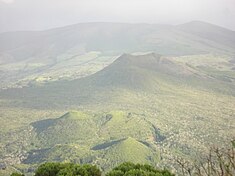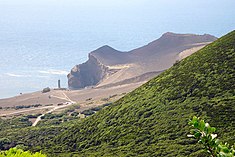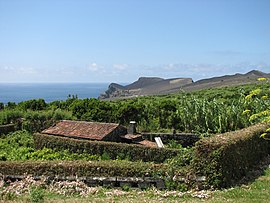|
Capelo
Capelo is a freguesia ("civil parish") in the municipality of Horta on the island of Faial in the Azorean archipelago. The population in 2011 was 486,[1] in an area of 26.64 km2.[2] Capelo may be considered the westernmost settlement of Eurasia, if Fajã Grande, on Flores Island, is considered part of North America, for it sits on the North American Plate. HistoryThe village was elevated to civil parish in 1600, when it was de-annexed from the neighbouring parish of Praia do Norte. Friar Diogo das Chagas, in 1643, noted that the parish had about 160 inhabitants, and approximately 44 residences. At its largest, the population reached 1,400 inhabitants. The town was practically destroyed in 1672 and 1673 during the volcanic eruption of Cabeço de Fogo (the name of the central volcano on the island of Faial). During this eruption, volcanic ash and pyroclastic projectiles rained down on the community, destroying homes and sterilizing agricultural lands in Capelo and Praia do Norte. Ironically, between 1673 and 1845, Praia do Norte was integrated into the civil parish of Capelo. The Church of the Santissima Trinidade (Church of the Holy Trinity) in Capelo, was ordered constructed by the Captain-major, Jorge Goulart Pimental, to replace the parochial church, the Chapel of Nossa Senhora da Esperança (Our Lady of Hope), which was destroyed during the 1672 volcanic eruption. A chapel to Nossa Senhora da Esperança was later constructed near the old church (which has since disappeared from the landscape). The chapel of Varadouro was founded in 1720, by Father Manuel Pereira Cardoso, to the invocation of Nossa Senhora do Carmo (Our Lady of Mount Carmel). Later, in his 1725 last testament, Father Cardoso requested that his inheritors celebrate a mass in perpetuity to the name Nossa Senhora do Carmo, the Holy Sacrament, and Santo António, on every first Sunday of October. The spa at Varadouro was constructed and inaugurated on 1 August 1954 by architect Read Teixeira. Geography  Physical geographyMountainous volcanic craters cover the majority of the parish (being the location of the most recent volcanic eruption in the Azores). The parish has several facets: an area of volcanic craters that extends from the islands caldera, inland pasturelands used to support the agricultural/dairy industry, and a coastal zone of cottages and oceanfront pools. Linking these areas is the ubiquitous Regional Road E.R. 1-1ª that connects the communities on the island with Horta in the southeast corner. The parish is located on layers of volcanic materials referred to as the Capelo Volcanic Complex. It is a line of volcanic escoria cones of fissural nature lying on a west-northwest-east-southeast orientation consisting of basaltic volcanism of low explosivity. The peninsula shows varying volcanic shapes and products resulting from surtseyan, Hawaiian and strombolian phases of volcanism. It is area of young rock (less than 10.000 years), overlying the older pyroclasts of the Caldeira Formation, and includes two historical eruptions (the 1672 Cabeço do Fogo and 1957 Capelinhos eruptions). This fractural zone is defined by the Capelo Fault, a fracture system of cones and craters displaying right lateral echelon geometry, which extends to Capelinhos volcano in the western tip of Faial. In this particular area, Capelo Fault is expressed by tens of sub-vertical fractures, concentrated in a 250 meter wide zone, cutting through the pyroclastic sequence of a surtseyan cone exposed in a paleo-sea cliff east of Capelinhos volcano. An example of these fractures can be found on the surface of the Capelinhos volcano; a warm vent on its eastern flank belies the active nature of this volcanism. Ecoregions/Protected areasThe parish is crossed by several pedestrian hiking trails connecting the volcanic cones along the Capelo Volcanic Complex: Cabeço do Fogo, Cabeço Verde and Cabeço do Canto, as well as interesting geological sites such as Fonte dos Namorados. Capelo is also known for its micro-climate, which has allowed the cultivation of grapes and small wine production. The areas along Canada das Adegas (in Norte Pequeno) and Varadouro are characteristic of these private holdings and "adegas". In addition, two major protected areas fall within the frontiers of the parish:
Further, and also included in the Capelinhos-Nordoeste-Varadouro region is the Parque Florestal do Capelo (English: Forest Park of Capelo), a region that extends from the central Capelos cape to the coast between Biscoitos and Varadouro used as leisure/recreative forest park. The Geographer Christophe Neff working since 1999 on environmental changes and vegetation dynamics and plant distribution in the different landscapes of the Capelo area, wrote recently in his blog, - that Capelo has considerably changed in the last twenty years, - more tourism, more secondary houses, and more vineyards are now part of the landscape of Capelo.[3] In the same text he remarked, that in 1999 Capelo was a very fare remote area, the End of the world, “Fim do Mundo”, the same name as a bar, that was situated, in Norte Pequeno in the North of Capelo. ClimateCapelo has a humid subtropical climate at low altitudes and a wetter oceanic climate at higher altitudes.
Human geographyIn addition to the village of Capelo, at the intersection of the E.R.1-1ª and E.R.3-2ª, the parish includes the localities of Areeiro, Biscoitos, Canto, Cimo da Ribeira, Cruzeiro, Norte Pequeno, Ribeira do Cabo, Rua do Canto, Rua da Igreja and Varadouro. EconomyThe economy in this region is primarily agriculture-related, with dairy-oriented activities dominating. Meanwhile, owing to the numerous natural monuments in the region (the aforementioned Capelinhos volcano and protected areas), the region regularly sees eco-tourist activities throughout the year, with rural tourism, pedestrian trails and other leisure activities occurring in the areas of Capelo and Varadouro. The parish's southern coast is considered the "spa region" of the island, dominated by a large bay and the black rock cliffs of Varadouro and the Mouro volcanic plug. Discovered in 1889, the warm waters at Varadouro were considered, at the time, one of the best medicinal treatments in the country for rheumatism and skin diseases; its hypersaline waters whose temperatures average 35.5 °C (95.9 °F), attracted "beachgoers" who travelled to the ocean-carved pools for refreshment during the Gilded Age, while partaking of the thermal waters at the spa.[5] Since this period, the use of the thermal waters has been intermittent, during phases of proactive local governments; around the late 20th century the buildings were already in ruins.[5] Plans to economically rejuvenate the area were concentrated on reconstructing the buildings, as a way to attract new visitors. But, in November 2007, these small plans were suspended in order to redevelop the site into a Hotel-Spa facility.[5] These plans stagnated until 2009 when, along with INOVA, the regional government proposed a new project to revitalize the thermal-spa potentiality of the Azores (called TERMAZ), which projected the reconstruction of the existing Varadouro spa buildings: a project that was stalled by 2011.[5] Amid opposition declarations requesting a timeline for their reconstruction, by 2011, the Regional Government indicated their intention to expropriate lands necessary to "re-qualify and reactivate" the Thermae of Varadouro (and suggesting that only 10% had not been acquired until this point).[6] ArchitectureCivic
Religious
CultureFestivitiesIn addition to the festivals associated with the Holy Spirit (which occur several weeks following Easter), the parish is the center of the Festas do Varadouro. This religious celebration is associated with the testamente of Father Cardoso who requested his heirs celebrate a mass in his Chapel of Varadouro in the name of Nossa Senhora do Carmo (Our Lady of Carmo). The celebration occurs on the first Sunday in October. TourismTourism in this parish is associated primarily with the main sites: Capelinhos and Varadouro. The re-qualification of the primary roadways within the past few years has been a process of improving and developing rural, eco- and geo-tourism. Similarly, with the emphasis on improving tourism in the Varadouro region, the natural rock pools have been improved and thermal spa in planning for remodeling. ReferencesNotes
Sources |
||||||||||||||||||||||||||||||||||||||||||||||||||||||||||||||||||||||||||||||||||||||||||||||||||||||||||||||||||||||||||||||||||||||||||||||||||||||||||||||||||||||||||||||||||||||

